Ultrabook Head to Head: Acer Aspire S3 vs. ASUS UX31E
by Jarred Walton & Manveer Wasson on December 21, 2011 5:40 AM ESTAnd Then We Get to the LCDs…
Sadly, as much as some areas of the laptops are improved over other offerings, the displays in general are nothing to get excited about. The Acer LCD is a bog standard model while the ASUS goes for a higher HD+ resolution and one of the brightest backlights we’ve tested on a laptop; unfortunately, contrast ratio along with color quality and gamut are all in the dumps. Let’s not dwell on it too much before we see the charts.
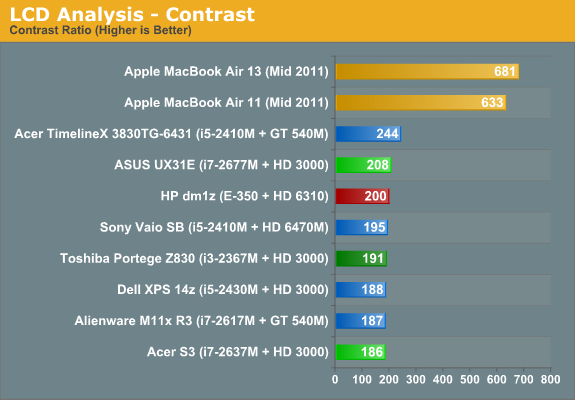
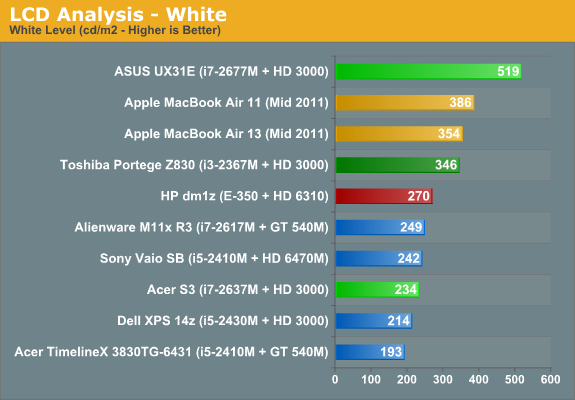
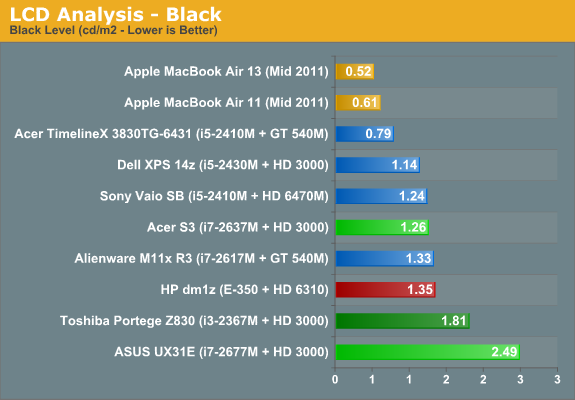
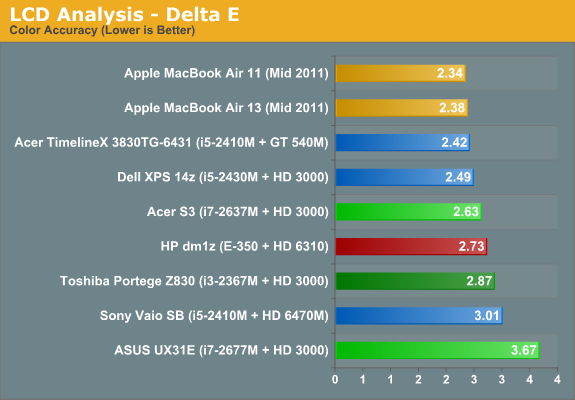
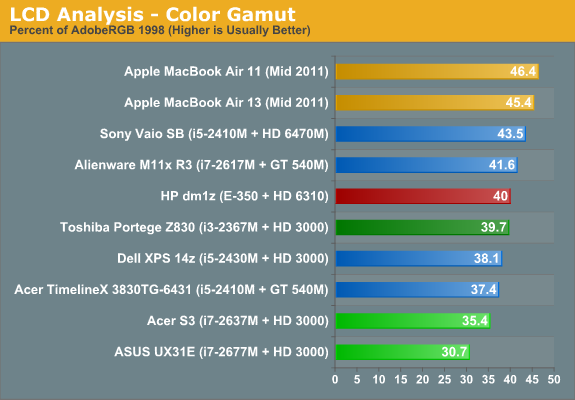
Of the laptops we’ve reviewed recently, the UX31E has the brightest LCD by far…along with the highest black level by far. The result is a contrast ratio that places near the top of our selection of eight mediocre displays. The Acer S3 on the other hand has middling white and black levels but the lowest contrast of the eight tested laptops. Continue on to color accuracy and gamut and things go from middling to lousy. The ASUS’ incredibly bright backlight results in very poor post-calibration Delta E of 3.67, with some colors in the double digits. Turn to the color gamut and we find part of the reason for that: the gamuts of both these ultrabooks are very poor, which means several of the test color patches are outside of their color range.
Viewing angles are typical of TN panels, with the vertical shots showing major color shifts. The ASUS panel does a lot better than the Acer, though neither one is great. We’ve got excellent 10.1” IPS panels now shipping in $400 tablets; why can’t we get a similar panel in 13.3” trim in a $1200 laptop? I’m probably preaching to the choir, but seriously: first IPS panel in a 13.3” laptop for under $1000 gets an Editor’s Choice award (as long as the rest of the laptop doesn’t completely suck).
In the grand scheme of things, though, how much do the LCD test results really matter? That’s a more difficult question to answer. Some users will never know what they’re missing, while others like to edit photos or watch movies and will immediately notice the poor contrast and colors. The color quality is a potential deal breaker for me, but if you’re just surfing the web and working in office applications, it really doesn’t make that much of a difference. For a go-anywhere laptop, the ASUS’ ultra bright LCD is definitely a plus—I took it outside and maxed out the backlight intensity and was still able to view the display contents without complaint, which is more than I can say for the laptops that max out at 200-250 nits.
When we look at the target the ultrabooks are trying to take down—Apple’s MacBook Air—the LCD results in particular are unacceptable. The MacBook Air displays are by no means perfect (I'd like a color gamut of at least 70% AdobeRGB for example), but notice how out of the tested laptops they place at the top in every test other than maximum brightness? That's what we'd like to see from the competition. ASUS at least made some effort to be different by going with a 1600x900 LCD with a high maximum backlight intensity, but Acer could have literally picked up any other 13.3” LCD and put in a similar showing. Take the price and OS out of the equation and the MacBook Airs are the superior “ultrabooks”, for two reasons: build quality and display quality. Acer improved their build quality over most of their budget offerings, and ASUS is right there with Apple in terms of build quality, but >500:1 contrast with >350 nits maximum brightness is the minimum I’d like to see, and really we’re talking about $1000+ laptops so it’s not too much to ask for an extra $50 to improve the displays.






















81 Comments
View All Comments
JarredWalton - Thursday, December 22, 2011 - link
At 100 nits the UX31E has a white point of 93.39 and a black point of 0.44, giving a contrast of 212:1 -- basically it doesn't change.cobalt42 - Wednesday, December 21, 2011 - link
Thanks for the review.I just wanted to say I appreciate that you show a nice, direct picture of the keyboard layout and include some discussion of dedicated home/end/pageup/pagedown/insert/delete keys. That's the main thing keeping me away from MBAs, and these two don't get it quite right either. (Yes, I use those keys constantly. Chording is not acceptable when there's plenty of space on the keyboard for dedicated keys. And is that a power button KEY on the Asus? How often do you need to hit the power button that you need to waste an entire key for it? Insane.) The Toshiba Z830 has a good key layout, but too many other things wrong with it like the ridiculously low resolution.
tim851 - Friday, December 30, 2011 - link
I HATE it, when they place a dedicated row of Home/End/... buttons next to the keyboard. I tend to hit the Delete and Enter keys on the right edge and if that row is present, I will oftentimes hit one of its keys alongside the one I mesnt to press.That's why I find I have little choice when it comes to 13" laptops, because most of them have that dreaded row of keys.
Please, leave the few that don't, alone!
ccd1 - Wednesday, December 21, 2011 - link
Santa brought me an early Christmas gift of the Dell 15z. Santa had read the review here and ordered the 15z with only two upgrades, the 1080 display and a 256k SSD. Based on my brief use of this PC, I have these thoughts.Ultrabooks have the potential to expand portability to include larger machines. True portability stops at 14" right now, IMHO. It would be really nice to see a 15" ultrabook. The 15z kind of gets there, but not quite. A thinner, lighter 15z would definitely be more portable.
All of these machines need a really good docking station, ideally a combo laptop cooler and docking station. To have these machines double as desktops, would want one plug for the peripherals and be done with it. Right now I have my machine connected to a big display, keyboard, mouse, laptop cooler, mic, and HDD backup. The idea of plugging and unplugging all these peripherals to move the machine around is a real damper on portability. Love to have a docking station that plugs into the USB 3.0 port and be done with it.
r3loaded - Wednesday, December 21, 2011 - link
It's funny to note that the Asus Transformer Prime (practically the stylistic tablet equivalent of the Zenbook) has a far superior display compared to these ultrabooks that cost more than double. I hope Apple can push the industry forward instead of letting them race to the bottom on displays.ibtar - Wednesday, December 21, 2011 - link
Pretty sure we've already hit rock bottom as far as LCD quality goes, at least in laptops. Only place to go from here is up, but who knows when that'll happen.Death666Angel - Wednesday, December 21, 2011 - link
Coming from a Travelmate 8172, my next notebook needs to look similar to:- 2 core CPU between 1.5 and 2.5GHz (4 threads optional)
- integrated GPU to play HL2-ish titles at native resolution and medium settings
- 128GB SSD (performance on par with first SF-Generation or better) (mSATA SSD + 2.5" HDD optimum)
- 4 GB RAM (8 GB optional)
- matte 12.1" to 13.3" LCD with 1600x900 (good brightness appreciated, contrast and color replication secondary)
- weight below 1.5kg
- thickness anything under 3cm, length and width as the display allows plus medium bezel
- no ODD
- trackpad area separated from rest of the chassis, keyboard keys as big as possible for the chassis
- 60Wh battery fully replaceable by the end user
- Intel WLAN adapter with 300+Mb/s, 2.4GHz/5GHz dualband (3G not needed)
- 2xUSB 3.0, 2xUSB 2.0, 1 Gb Ethernet and/or Thunderbolt
Price can be between 800€-1200€, depending on actual components.
What I will not buy anymore: 1366x768 in anything above 11.6", glossy LCD, anything without either USB 3.0 or Thunderbolt.
Snotling - Wednesday, December 21, 2011 - link
not ever again (unless its a smart phnoe)retrospooty - Wednesday, December 21, 2011 - link
"NOT going under 900p"Ditto.
Any product at all when I see 1368x768 I immediately tune out. So tired of that low res as a standard.
One good thing you gotta give Apple, is the retina display. To me its overkill for a phone, but if it can help to usher in the end of 1368x768 laptops then I applaud them. Thank you Apple!
nphewitt - Wednesday, December 21, 2011 - link
Apple uses MagSafe connectors, not MagLock. Kleenex vs Tissue, whatever. Just putting it out there.